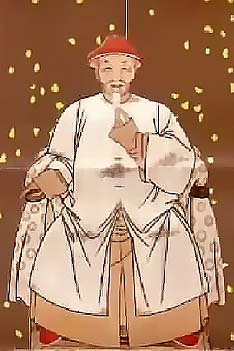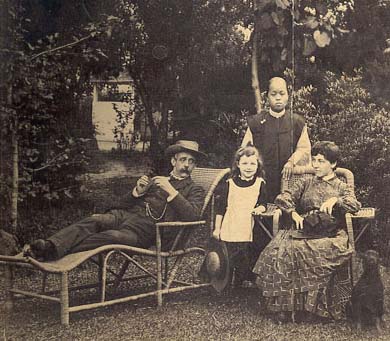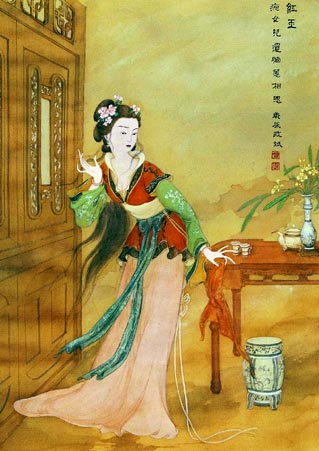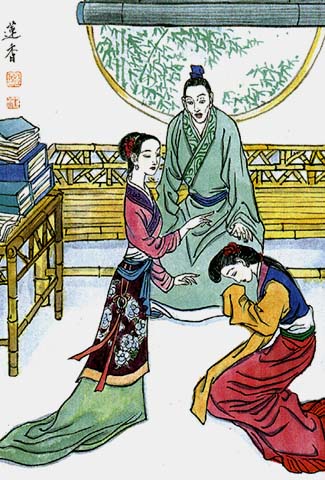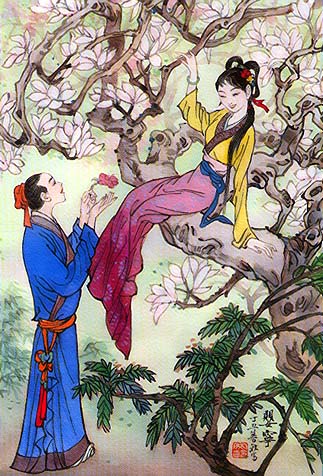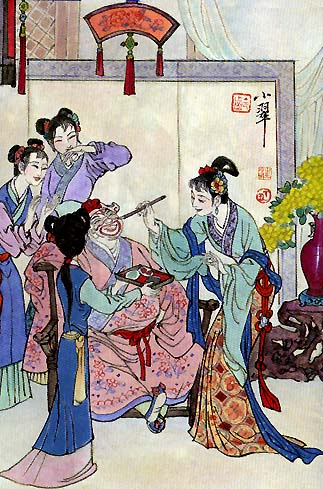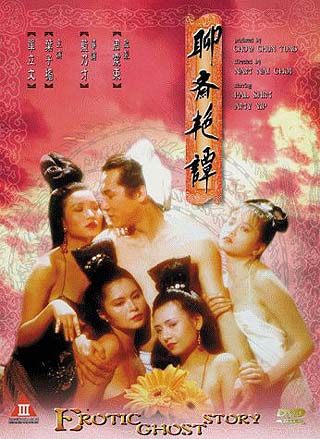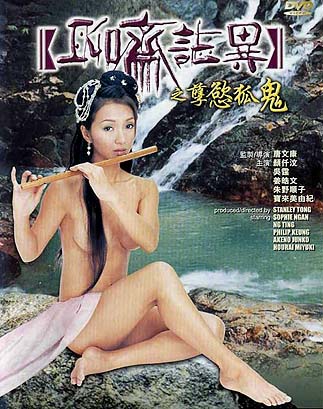|
|||||
| Chinese Fox Myths | |||||
| Introduction
One of the first papers in English on Chinese Fox Myths was read by Thomas Watters before the April 1873 meeting of the North China Branch of the Royal Asiatic Society at Shanghai. Watters was a British consular official who had been stationed at Takow (Takao, Kaohsiung) in 1866 and was to return to Taiwan later in the 1870s. |
|||||
| In his paper Watters discusses the two major perceived characteristics of the fox [狐狸, hu-li] according to Chinese beliefs: its exceedingly long life, and its great preponderance of Yin [陰], the female portion of things. The life of the fox, through its craftiness, was believed to extend to 800 or 1,000 years, and he could even achieve immortality. As a result, temples and shrines were built to the Fox-genius [ 狐仙廟]. The fox's accumulation of Yin is due to his nocturnal habits and this enabled the fox to easily assume the guise of woman. Further, as the fox naturally wishes to have a well-balanced constitution, it looks to gather Yang [陽], the male element, wherever it can. Thus is created the powerful myth that the fox-spirit must prey on the life-force of men in order to achieve longevity. |
|
||||
|
The best known Chinese stories written about fox-spirits are those written by Pu Song-ling [蒲 松 齡], in a collection known as 'Strange Tales from a Chinese Studio' or 'Laozhai zhiyi' [聊 齋 誌 異] made in the late 17th century. |
|||||
|
Pu Song-ling (P'u Sung-ling) 1640-1715 |
Pu Song-ling was born in Shantung province in 1640. Although he passed the
first Imperial examination before he was twenty, he never succeeded in passing the second, the
all-important master's degree, due to his neglect of academic study. He thus never attained
lucrative public office, except for a brief appointment as an aide to a county magistrate in
Kiangsu after which he returned to his home town and worked as a private tutor. His overriding interest was in tales of the supernatural. Many of the stories in his Liaozhai collection are retellings of old tales from the Tang dynasty and earlier: Pu Song-ling was a drinker and a listener. As he himself writes, ' in the lapse of time my friends from all quarters have supplied me with quantities of material, which, from my habit of collecting, has grown into a vast pile'. However, upon this collection of folktales and old stories he indelibly stamps his own style and notably adds his own opinions on male-female relationships. The Liaozhai Zhiyi, or 'Strange Stories from a Chinese Studio', contains no less than 491 tales. His book circulated in manuscript form for many years, before finally being published posthumously by his grandson in 1740. An alternate title was 'History of Foxes and Ghosts'. |
||||
|
Although in Pu Song-ling's writings the fox spirits appear in both male
and female form, the most famous tales are those of fox-spirits appearing as
beautiful young girls. However, it should be noted that, out of the 491 tales, only 86
mentioned foxes and just 34 of these touched on sexuality.
Some 160 of Pu Song-ling's stories were translated into English by Herbert A Giles, who is perhaps best known as the developer of the Wade-Giles system of transliterating Chinese characters into Roman script. Giles' translations were first published as two volumes in 1880. Although there have been subsequent translations, Giles remains the best source for the English speaker and his books are easily and cheaply available either second-hand (try abebooks.com) or as reprints (Elibron). However, to catch all the sexual subtlety one needs to delve deep into the Chinese texts. The following are some of his fox stories. |
Herbert A Giles (1845-1935) shown in his garden at the Ningbo British Consulate in 1889 |
||||
|
|
The tale of
'Hong-yu [紅玉],
the Fox Fairy' begins as a supernatural one-night stand. This
is one of the earliest forms of the fox myth, where the fox-fairy robs
the man of his jing [精],
meaning his sperm and life essence, in order that the fox may live
its full life. As mentioned above, the fox-spirit is always in the quest
of Yang, the male element, to balance its constitution. In the
earliest tales the fox-spirit would arouse the man to multiple orgasms
during the night and would then slink out, sometimes to be sighted in
fox-form, before dawn.
However, in this story, Hong-yu does not simply flee the next morning, but attentively returns. Moreover, when scorned by the man's father, she finds her seduced scholar a beautiful human woman as a substitute. Tragedy soon befalls the scholar when a powerful man kidnaps the young substitute wife, who then commits suicide rather than be raped. Next, with suspicion for the subsequent murder of the kidnapper falling on the scholar, his infant son is thrown down a mountainside and left for dead. Following these tragedies, Hong-yu reappears as the saviour. She rescues the son and returns to help the man reestablish his life. Thus, by the end of the story, Hong-yu has acted as her supposed victim's righteous saviour and not as his parasite. |
||||
|
The fox-spirit, with its vital quest for Yin, is seen to
profit from excess sex. The only other being to profit from sexual
excess is perhaps the prostitute. Indeed Watters found a temple in Foochow (Fuzhou) dedicated to the
Fox, called the Nine Officer Temple
[九使]
, where the local prostitutes would pray.
In the tale of Miss Lien-hsiang, or Lianxiang [蓮 香 ], the fox-spirit appears in the guise of a prostitute. The story is notable in that it contains the refutation that fox-spirits will especially drain a man's vigour. Lien-hsiang points out that any over-indulgence, either with a fox-spirit or with a human, will deplete the man. In this tale, Lien-hsiang is part of a love triangle of two girls and a scholar named Sang Tsu-ming, but Pu Song-ling adds an intriguing twist. One lover is a virginal ghost called Li, who comes from a good family; the other lover is the sexually-experienced fox Lien-hsiang. Yet, in this story it is the ghost Li who is the cause of the sexual over-indulgence, not the fox-spirit Lien-hsiang who again assumes a saviour role for the scholar Sang. The illustration on the right shows Lien-hsiang admonishing Li for her sexual predation, as the depleted Sang looks on. |
|
||||
|
Wang presents the faded plum-blossom to the laughing Ying-ning and declares his love |
In the tale of
'Ying-ning, the Laughing Girl' [嬰寧],
Pu Songling moves his character far away from the notion of the
sexually-experienced fox-girl. Ying-ning is a superbly naive girl who is
constantly laughing and has a special fondness for flowers.
At the Lantern Festival, a young scholar named Wang Tzu-fu [王子服] is bewitched by the beautiful Ying-ning who throws a spray of plum blossom on the ground for him. As Wang ails, his cousin seeks to placate him by telling him that Ying-ning is his distant cousin living in a village about 10 miles away. Wang recovers and longs to visit Ying-ning, but the cousin always excuses himself, as he had never found the girl. Eventually, Wang sets out on his own and duly finds such a village and the giggling girl Ying-ning. After declaring his love, he takes the Ying-ning back as his wife. Yet while her incessant laughter delights many, it drives her parents-in-law to despair. However, her obsession with flowers leads to her transformation. When a neighbour sees her climbing a trellis in the search of a fine rose, he mistakes her laughter as flirtation and an invitation to a tryst. That night he embraces her and penetrates her, only to feel excruciating pain; it turns out that he has embraced a hollow tree with a scorpion hidden inside and soon dies. Chastened by this experience Ying-ning accepts her mother-in-law's admonition and laughs no more, becoming a dutiful wife. |
||||
|
The tale of Hsiao-tsui, Xiaocui [小翠],
is similar to that of Ying-ning, both being about the attempts of a
daughter-in-law to adapt to her new family. In this story the fox-spirit
Hsiao-tsui marries the idiot son of the man who had long before
protected her fox body from lightning.
The tendency for supernatural wives to have passive husbands is taken to extremes in this tale. Hsiao-tsui delights in dressing up her husband and acting out roles with him (see illustration on right). These bizarre games serve to alienate and enrage her parents-in-law. The difficulties with her parents-in-law are further increased by the lack of a child. The problem this time is the husband's sexual naivete and his idiocy, both of which Hsiao-tsui dramatically cures. Thus the fox-spirit becomes atypically the sexual saviour and not the sexual destroyer of a man. No sooner has Hsiao-tsui made her human husband whole, than she falls foul of his ungrateful parents again over a broken vase. This time she leaves the family and returns to the fox-world, replacing herself with a human bride who gradually assumes Hsiao-tsui's looks. Thus, Pu Song-ling comments, the nobility of the fox-spirit is shown. The fox repays the human favour by marrying and curing the idiot son, yet the human family prove unworthy of her through their worldly pettiness. |
|
||||
|
|
|||||
|
Fox Myths in Movies |
|||||
| No look at Chinese fox-myths would be complete without a glance at their present-day popular expression in the cinema. The Hong Kong movie industry has delved into the fox-myths and presented them in a way to appeal to modern audiences. Below are two examples of the genre. | |||||
|
|
Erotic Ghost Story, loosely based on Pu Song-ling's story 'Miss
Quarta Hu' [胡四姐], is a surprisingly explicit, visually vibrant, fast-paced adult comedy
from Hong Kong that should appeal to any dabbler in Chinese erotica.
The
movie revolves around three sister fox-spirits (one played by Amy Yip)
who are nearing immortality after almost a thousand years of meditation.
Hoping to see
out their final thirty-six days to immortality in the required celibacy,
the sisters move to a rural village. But one sister's visit to the local temple
of the fertility god Wu Tung awakens her carnal desire. Although the performances are not great, Amy Yip is fun to watch. Though Yip sticks to her ‘no full nudity’ clause, her fox-sisters have no such qualms about being naked, and the film has some very erotic moments. This movie spawned many clones and sequels, but none bettered the original. |
||||
|
Fox Ghost
[聊齋誌異之孽慾狐鬼]
may be just another shabby period sex comedy, as reported be one
reviewer, but it is surely redeemed by the presence of the lovely and talented Sophie Ngan Chin-man,
shown on the DVD cover on the right. The story is again supposedly based
on a tale from Laozhai.
A scholar dares to travel through a forest reputedly haunted by the wandering spirits of murder victims. Along the way, he encounters beautiful young noblewoman, played by Sophie Ngan, and convinces her family to let him stay in the haunted cottage behind their home. The place is aptly named as, that evening, he is visited by a pair of sexy fox spirits who scare him into a state of unconsciousness. In no time, the sly scholar has convinced the young noblewoman's father to let them marry and, although the girl is a virgin, she very quickly warms to sex and soon becomes the aggressor in the relationship. Although the scholar has the characters for "Top Notch" tattooed on his "golden cudgel", the girl's insatiable sexual desires are leaving him drained, so he comes up with a way to spend some time away from home. However, his abstinence is short-lived and the two foxes are soon sharing his bed. |
|
||||
|
|
|||||
| The
reader is referred to the following sources which have been used for
this page:
聊 齋 [Liaozhai], 世一文化事業股份有限公司 [Acme Cultural Enterprise Co Ltd], 台南市[Tainan City], 2002. Herbert A Giles (translator), 'Strange Stories from a Chinese Studio', Kelly & Walsh, Shanghai, 1926. Pu Songling, 'Liaozhai Stories - Of Fox-fairies, Ghosts & Other Marvels', Asiapac Books, Singapore, 1993. Rania Huntington, 'Alien Kind: Foxes and Late Imperial Chinese Narrative', Harvard University Asia Center, 2003. Thomas Watters, 'Chinese Fox-Myths', Journal of the North China Branch of the Royal Asiatic Society, Volume VIII (1874), pps 45 to 65. |
|||||
|
|||||

